Spotlight on the Neuberger Museum of Art
The Neuberger is open Wednesday – Sunday from noon to 5:00pm (Closed Monday – Tuesday).
Admission is currently FREE for all visitors.
We spoke with members of the Neuberger staff about why everybody should stop by for a visit, and their favorite current pieces.
Tracy Fitzpatrick, Director of the Neuberger Museum of Art
Everyone on staff should stop by because we are their museum. We belong to them.
It’s hard to pick just one favorite piece, but right now I love Robert Watt’s table shaped like a lambchop. I might love something different tomorrow!
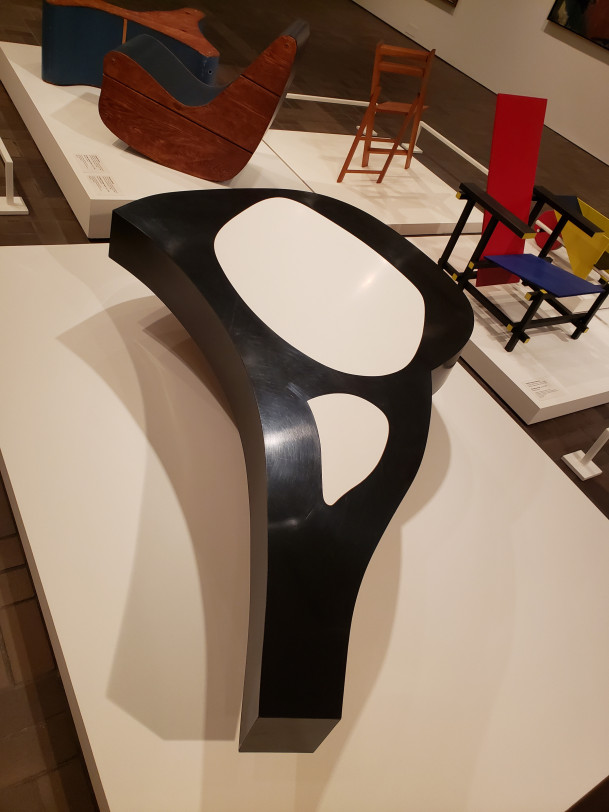
Burlington, Iowa, June 14, 1923 – Martins Creek, Pennsylvania, September 2, 1988
Lamb Chop Table, 1964
Formica on wood
16 1/2 x 80 x 50 inches
Collection Neuberger Museum of Art
Purchase College, State University of New York
Gift of William L. Bernhard
1989.02.01
Photo credit: Installation Photo
Art: © Robert Watts Estate
(A table in the shape of a lamb chop that is mostly black with two varying sized white areas. One large white area is at the center of the wider end of the table with a small white area extending into the narrow end)
Patrice Giasson, Alex Gordon Curator of Art of the Americas
What I like about our museum is that we are based on a university campus and that we are a teaching museum. Students from very different disciplines (art, history, music, dance, science etc.) bring a lot the museum. They frequently perform in our premises and they also assist us through internships, for instance. They are also our first audience, and they can trigger very interesting questions. I also appreciate the fact that many of my colleagues are scholars, and that we frequently collaborate, either through publications or exhibitions. I also like the fact that we get to work on exhibitions that are not exclusively blockbusters. Though we do work with some of the most renowned artists, we also bring forward less-known artists, or undertake challenging, but meaningful exhibitions.
There are so many works that I like in the collection. I would say that one of my favorites is the Edward Hopper’s Barber Shop (1931), presently on view, as well as Henry Moore’s Large Two Forms (1966-1969) the first outdoor sculpture that you see entering Purchase College.
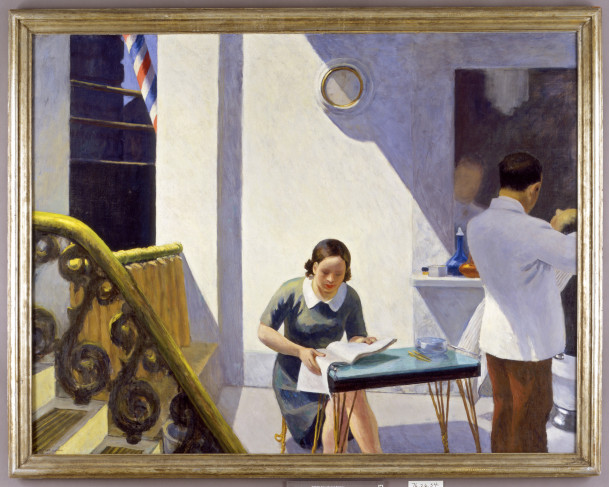
Nyack, New York, July 22, 1882 – New York City, May 15, 1967
Barber Shop, 1931
Oil on canvas
60 1/8 x 78 ½ inches
Collection Neuberger Museum of Art
Purchase College, State University of New York
Gift of Roy R. Neuberger
1976.26.54
Photo credit: © Jim Frank
(A painting depicting a woman seated at a small table reading a magazine inside a barber shop. The foreground has a portion of a flight of stairs with an ornate handrail. The woman is in the center of the painting. The barber is to the right cutting the hair of a mostly obscured person. There is a clock on the wall behind the woman and a blurred mirror to the right of the clock. The barber's head is lightly reflected but blurred in the mirror)
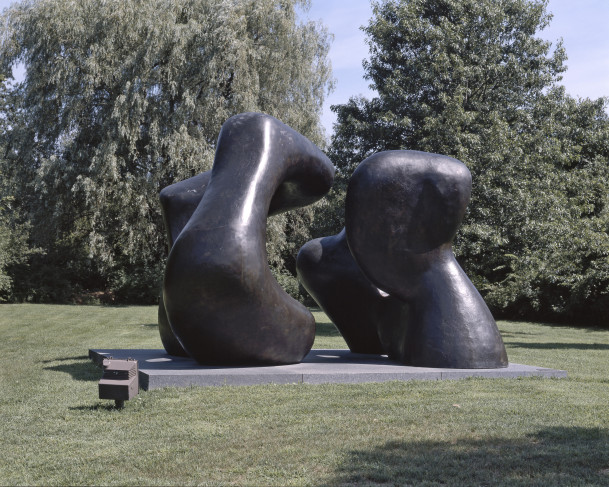
Castleford, West Yorkshire, England, July 30, 1898 – Perry Green, Much Hadham, Hertfordshire, England, August 31, 1986
Large Two Forms, 1966-1969
Bronze
From an edition of 4
144 x 204 x 184 inches
Collection Neuberger Museum of Art
Purchase College, State University of New York
Gift of the artist and Marie S. and Roy R. Neuberger
1974.38.01
Photo credit: Jerry Thompson
Art: © Henry Moore Foundation
(A pair of large bronze organic forms sit next to one another with space to walk between them. The sculptures have openings their centers where one can look through both. There are trees a short distance behind the sculptures. The composition rests on a stone platform on a grassy area at the entrance to the Purchase College, SUNY campus. The photograph of the sculpture was taken in the spring or summer)
David Bogosian, Chief Preparator & Director of Facilities
A deeply meaningful aspect of working at the Neuberger Museum of Art, in spite of the fantastic holdings of the permanent collection, is the people–those here now and throughout my 17 years here. They have consistently been an interesting, kind and smart staff who I learn from every day. It’s been a rewarding growth experience to work closely with a team with such a deep knowledge base and so adept at imaginative solution finding.
Why should staff stop by for a visit? Because we have great art, both from our collection and on loan from others in the rotating exhibitions on view.
I might name a different favorite piece on any given day – there are so many fascinating and exquisite works in our collection. Today my favorite is a tapestry based on the renowned Hans Hoffman painting To Miz - Pax Vobiscum. The translation of that painting into a woven textile is executed with phenomenal precision and skill, rendering gorgeous saturated color and even capturing areas of brush strokes. This work is being considered for inclusion in a near term exhibition so you may get to see it soon. So worth it.
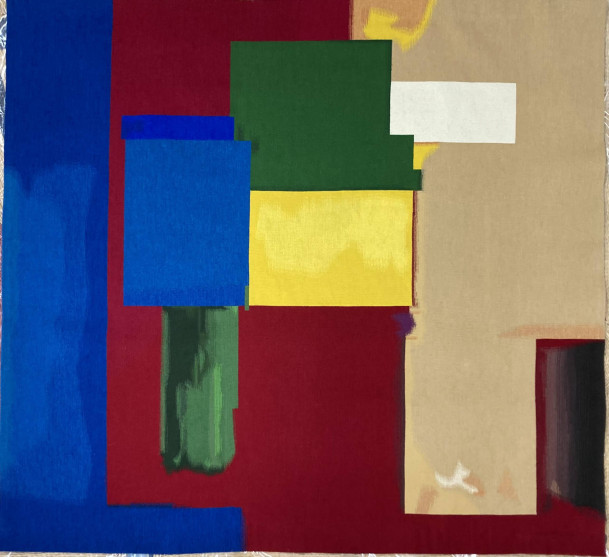
Weissenberg, Bavaria, March 21, 1880 – New York City, February 17, 1966
after “To Miz-Pax Vobiscum”, A Gloria Ross Tapestry, 1986
Wool
4 from an edition of 7
68 x 76 inches
Tapestry Editeur: Gloria Ross
Manufacturer: Pinton S.A. Felletin, France
Collection Neuberger Museum of Art
Purchase College, State University of New York
Gift of Gloria Ross
1998.12.01
Photo credit: Neuberger Museum of Art
Art: © The Hofmann Trust
(A geometric abstract woven tapestry made of wool. It is brightly colored with blues, red, yellow, greens, white and beige. Most of the shapes are block-style.)
Rebecca Elisabeta Marya (Rem) Ribeiro, Curatorial Assistant
What I love most about the Neuberger is how diverse the museum’s immense collection is – from subject matter, to medium, to decade, and even to international relevance. We have a really wonderful balance of artists and art works, and as a teaching institution, a diverse collection helps both the campus community and general visitors understand how wide-reaching and fluid art can be; it doesn’t have to be the “traditional” painting and sculpture by the same artists that so many people are familiar with. It’s nice to think that students especially can find inspiration through the museum, and implement that into their practice – regardless of their discipline.
It’s hard to say what my favorite piece is, and I think it’s changing constantly! I’m still learning so much about the collection. For now, my favorite piece is Mary Frank’s Moving Woman II from 1976. I remember doing a bit of research on it when I was studying at Purchase. It’s a really beautifully haunting sculpture that feels so human, and bursting with deep emotion. This work always catches my attention whenever I have the privilege of going down into storage! My appreciation for it grows, the more I find myself looking at its details.
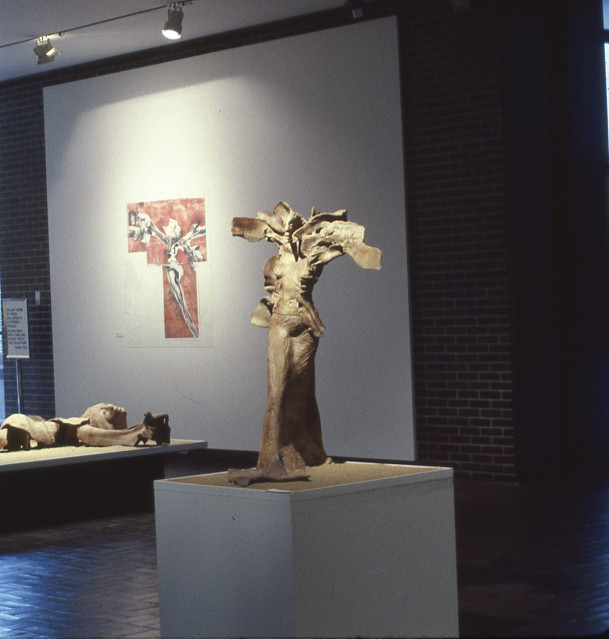
Born London, England, February 4, 1933
Moving Woman II, 1976
Ceramic
42 x 24 x 28 inches (overall)
Collection Friends of the Neuberger Museum of Art
Purchase College, State University of New York
Museum purchase with funds provided by the
Friends of the Neuberger Museum of Art
EL 77.04.01
Photo credit: unknown
Art: ©Mary Frank, courtesy D.C. Moore Gallery
Moving Woman image from 1978 exhibition Mary Frank: Sculpture, Drawings and Monoprints, June 4 – September 10, 1978
(An installation photograph of a beige 3D representation of a female figure. Around her head are slabs of ceramic that could be floral or cloud-like and give the sense of movement. Her proper right leg is extended forward giving the impression of walking ahead.)